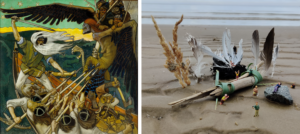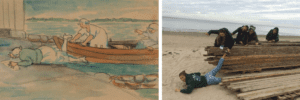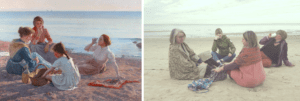Nature meets art. Or the other way around?
Päivi Tiura People with bathing suits on the beach from not dated
During the Conference 2019 in Latvia, EUROPARC held a number of workshops to discuss diverse topics relevant for Protected Areas management. In case you have not attended, or want to read about their outcomes, a series of online articles summarises the content of some of these workshops.
Nature has always inspired artists – painters, song writers, composers, dancers… Nature is the source of art. Art has been and will be inviting visitors – as individual artists or large groups like choirs – to Protected Areas. Art events at various scales can be arranged inside nature conservation sites to get new visitors to nature or used as a tool to interpret nature to various target audiences.
Art invites visitors to nature
Art may cause interesting controversies among nature and climate conservationists. The peat sculptures made in Latvia are beautiful as art pieces, if you happen to like them (see video). But why do we need to use centuries old carbon sink for art? Well, art has its freedom – we like some and don’t like other pieces of art.
Before we entered the topic of the real life of artists, we heard a presentation from Ms. Sanna-Kaisa Juvonen from Metsähallitus Parks and Wildlife Finland on the kinds of art events that have been organised in Finland. Lighting old castle ruins to depict the story of medieval Raasepori castle ruins was a spectacular way to bring light art into castle ruins (see video).
We also heard Finnish choirs sing the Finlandia hymn by Sibelius at nature day events celebrating the 100th anniversary of Finland (see video above).
During one day, over 1 500 singers performed nature related songs in 37 national parks.
Let’s make some art – it’s easy and fun
Within the workshop, participants were asked to recreate art in two different stages. First we selected over 50 Finnish paintings and asked people to make new interpretations of the paintings they liked in miniature scale using ”Slinkachu” approach. That means they should use small figures, usually used in mini railways.

Akseli Gallen-Kallela Defending the Sampo from 1896
After a small break we gave them new instructions: ”now you are people in the paintings”. The same paintings were re-illustrated at full scale. It was easy, creative, and fun!

Elin Danielsson On the shore from 1904
We need more chances to talk with artists
As it happens, we are too often comfortably working in our own silos. We agreed in our group that we need to be more courageous and get in contact with artists. We need more platforms for joint discussions with people from different sectors. And also, we could simply invite more artists to our events focusing on nature. Moreover, we know that both creating art e.g. singing and being in nature is good for our mental and physical health. Double win!
Artists get to create art in nature, and we might get new visitors to our sites – interconnecting the nature and art sectors would be mutually beneficial.
It is a bit peculiar that at work we collaborate usually with our colleagues who are also working in the field of nature conservation. But in our private life, we can do very different kind of activities – we sing in choirs, make paintings, write poems, act in local theatre groups. You and your colleagues might actually be amateur artists, but we seldom use art in our work. Perhaps we should?
Let’s be more creative and next time you plan an event, think what role art could play in the event.

Elin Danielsson On the shore from 1904